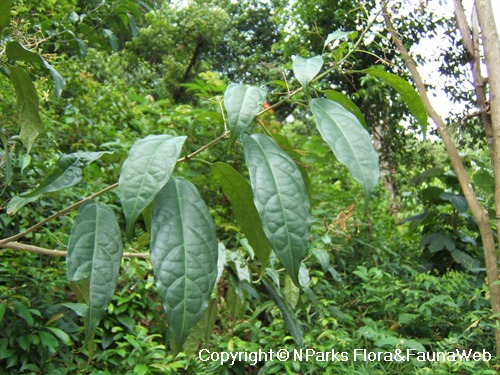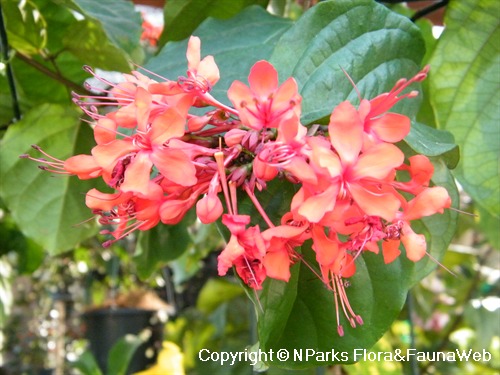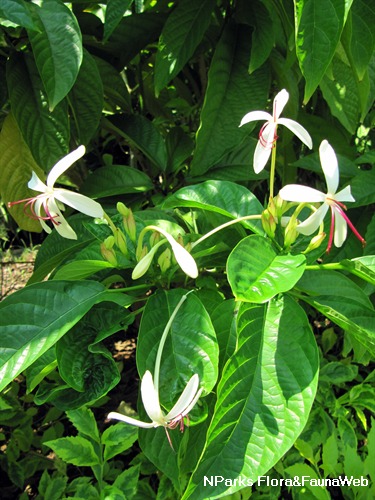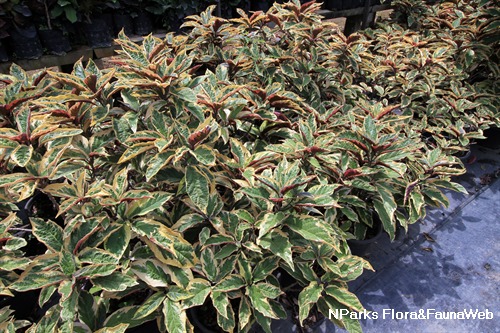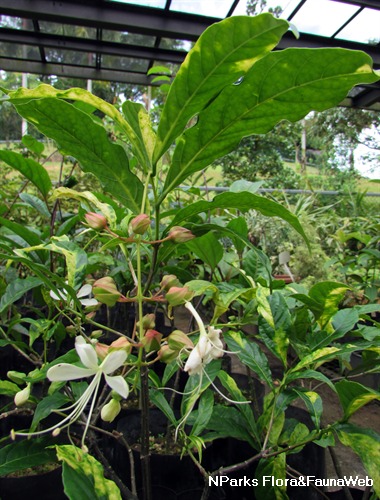
Back
Clerodendrum disparifolium Blume
| Family Name: | Lamiaceae (Labiatae) |
| Synonyms: | Clerodendrum laevifolium auct. Non Blume <2>, Clerodendrum acuminatum Wall. ex Schauer |
| Common Name: | Swaddling Flower, Guriam, Lampin Budak, Lelampang Badak, Puding, Unting-unting 不等叶大青 |
Clerodendrum disparifolium or Swaddling Flower is a shrub or slender tree native to Singapore that grows to 14 m in height. It has shiny green leaves, 5-lobed, smooth to velvety, pale-yellow flowers and blue-black, fleshy, round fruit that sits on a crimson or white, fleshy, star-like structure left by the surviving flower parts (calyx).
Name
Classifications and Characteristics
| Plant Division | Angiosperms (Flowering Seed Plants) (Dicotyledon) |
|---|---|
| Plant Growth Form | Shrub, Tree (Small (6m-15m), Shrubby (1m-5m)) |
| Lifespan (in Singapore) | Perennial |
| Mode of Nutrition | Autotrophic |
| Plant Shape | Shrubby, Open |
| Maximum Height | 14 m |
Biogeography
| Native Distribution | Thailand, Sumatra, Peninsular Malaysia, Singapore, Java and Borneo |
|---|---|
| Native Habitat | Terrestrial (Primary Rainforest, Secondary Rainforest) |
| Preferred Climate Zone | Tropical |
| Local Conservation Status | Native to Singapore (Least Concern (LC)) |
Description and Ethnobotany
| Growth Form | It is a shrub or slender tree up to 14 m tall. |
|---|---|
| Foliage | Leaves are shiny green, generally broadly to narrowly elliptic, unequal size of 5-19 cm long and 2-8 cm wide. It has a pale coloured, smooth to velvety underside. Similarly, the grey-brown twigs carry similar texture of smooth to velvety. |
| Flowers | Flowers are borne on a loose inflorescence of 30 cm long with leaf like bracts at the base of each pairs. Each flower is 5-lobed, pale yellow coloured, tubular (up to 2.4 cm), smooth to velvety. |
| Fruit | It is a round drupe about 0.6 mm wide, olive ripening to blue-green then blue-black. The fruit sits on a fleshy, star-like, crimson or occasionally white, cup-like structure formed by the surviving outer flower parts (calyx). |
| Habitat | Occurs in lowland, hillside forest, forest ages up to 1280 m in altitude. <1,4> |
| Associated Fauna | It is the preferred local food plant for caterpillars of the butterfly, the fluffy tit (Zeltus amasa maximinianus), the adult of which lays its eggs singly on the bud, calyx or pedicel of the flower. Its flowers are insect-pollinated, and its fruits are eaten by birds. |
| Taxonomy | Previous name of Clerodendrum laevifolium auct. non Blume was misused in Singapore. Current name of Clerodendrum disparifolium Blume is applicable to wild plants in Singapore but not necessarily to wild plants elsewhere or to cultivated plants originating elsewhere. <2> |
| Cultivation | It can be propagated by seed or by stem cuttings. |
| Etymology | Greek kleros, chance; Greek dendron, a tree, supposedly an inference to the variable medicinal efficacies of the plants in this genus; Latin dispar, unequal; Latin folium, -leaved, referring to the unequal size of leaves. |
| Ethnobotanical Uses | Medicinal: The leaves alone or in a mixture of herbs, are used as traditional remedies to relief insect bites and stings. Research suggests Clerodendrum disparifolium contain antioxidant and anti-inflammatory properties which shown prospects to be developed for pharmaceutical needs. <3> |
Landscaping Features
| Landscaping | This plant can be grown in parks and gardens, and may be tolerant of roadside conditions. Although the crown is a bit untidy in appearance, it has attractive yellow flowers and striking fruits (round, black fruits surrounded by the star-like crimson or white sepals). |
|---|---|
| Desirable Plant Features | Ornamental Flowers, Ornamental Fruits |
| Landscape Uses | General, Suitable for Roadsides, Parks & Gardens, Small Gardens |
| Thematic Landscaping | Naturalistic Garden, Butterfly Garden |
Fauna, Pollination and Dispersal
| Fauna Pollination Dispersal Associated Fauna | Butterfly Host Plant (Leaves), Bird-Attracting, Butterfly-Attracting |
|---|---|
| Pollination Method(s) | Biotic (Fauna) |
| Seed or Spore Dispersal | Biotic (Fauna) |
Plant Care and Propagation
| Light Preference | Semi-Shade, Full Sun |
|---|---|
| Water Preference | Moderate Water |
| Plant Growth Rate | Moderate |
| Rootzone Tolerance | Moist Soils, Well-Drained Soils |
| Propagation Method | Seed, Stem Cutting |
Foliar
| Foliage Retention | Evergreen |
|---|---|
| Mature Foliage Colour(s) | Green |
| Mature Foliage Texture(s) | Glossy / Shiny, Raised / Sunken Veins |
| Foliar Type | Simple / Unifoliate |
| Foliar Arrangement Along Stem | Opposite |
| Foliar Attachment to Stem | Petiolate |
| Foliar Shape(s) | Non-Palm Foliage (Elliptical) |
| Foliar Venation | Pinnate / Net |
| Foliar Margin | Entire, Serrate / Toothed |
| Foliar Apex - Tip | Acuminate, Acute |
| Foliar Base | Acute, Rounded / Obtuse |
| Typical Foliar Area | Mesophyll ( 45cm2 - 182.25 cm2 ) |
| Leaf Area Index (LAI) for Green Plot Ratio | 3.0 (Tree - Intermediate Canopy) |
Non - Foliar and Storage
| Trunk Type (Non Palm) | Woody |
|---|---|
| Stem Type & Modification | Woody |
| Root Type | Underground (Tap Root) |
Floral (Angiosperm)
| Flower & Plant Sexuality | Bisexual Flowers , Bisexual Flowers |
| Flower Colour(s) | Yellow / Golden |
|---|
| Flower Grouping | Cluster / Inflorescence |
| Flower Location | Terminal |
| Inflorescence Type | Cyme |
| Flowering Habit | Polycarpic |
Fruit, Seed and Spore
| Mature Fruit Colour(s) | Black, Red |
|---|---|
| Fruit Classification | Simple Fruit |
| Fruit Type | Fleshy Fruit , Drupe |
References
| References | <1> Bramley, G.L.C., Go, R. & de Kok, R.P.J. (2011). Tree Flora of Sabah and Sarawak, vol. 7, pp. 36-37. Selangor: Forest Research Institute Malaysia. <2> Keng, H. (1986). Annotated List of Seed Plants of Singapore (5). The Gardens' Bulletin, Singapore 39(1):89. <3> Phosrithong, N & Nuchtavorn, N. (2016). Antioxidant and anti-inflammatory activites of Clerodendrum leaf extracts collected in Thailand. European Journal of Integrative Medicine 8(3): 281-285. <4> Wearn, J.A., Mabberley, D.J. (2011). Clerodendrum (Lamiaceae) in Borneo. Systematic Botany 36(4): 1050-1061. |
|---|
Image Repository
Others
| Master ID | 1520 |
|---|---|
| Species ID | 2813 |
| Flora Disclaimer | The information in this website has been compiled from reliable sources, such as reference works on medicinal plants. It is not a substitute for medical advice or treatment and NParks does not purport to provide any medical advice. Readers should always consult his/her physician before using or consuming a plant for medicinal purposes. |






